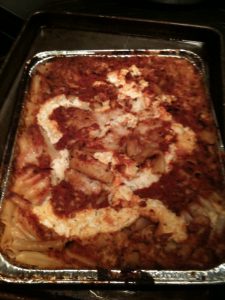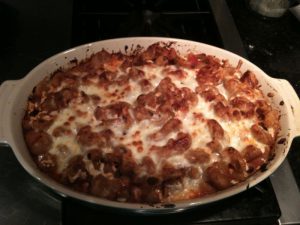A few weeks ago I made ziti for dinner. It’s an Italian staple for many reasons; it’s cheap, it’s easy, and it’s delicious. I made it with organic whole wheat pasta and smoked mozzarella, and my whole family devoured it.
But then I had an idea for an experiment. How would my homemade organic ziti compare in taste and price to either homemade chemical or frozen processed ziti? I was especially interested in price, since I am constantly asked why organic is so much more expensive than chemical food. But as the publisher of the great Eat This, Not That series, I was also curious to find out if there are any hidden fats, sodium differences, or calorie surprises between the alternatives. And since I have a new blog helper, Dana Blinder, to assist me on projects like this, we set a date for my house after work one night (in yes, the real Maria’s Farm Country Kitchen) to perform our ziti experiments. This wasn’t a science lab analysis, it was a kitchen lab analysis—armed with tablets, pencils, calculators and two hungry kids (four if you include us—I think my husband was at a baseball game during the cooking, but rest assured, he ate all the leftovers) we compared nutrition analyses and prices and flavor.
We cooked two zitis: my homemade (this time just with regular mozzarella) and a Celatano’s frozen white pasta ziti.
The first finding was that homemade was actually faster than frozen. A large (serves 9) frozen ziti takes more than an hour and a half in the oven—and it’s packed in tinfoil, so there was no cheating with microwaving. Homemade, including boiling water and cooking pasta beforehand, only took an hour (because the pasta is already hot, you only need to bake it for a half hour).
The second finding is that between all three (organic, chemical homemade, frozen) there weren’t major differences in calories, fat, sodium, and so forth. The biggest difference was that the store-bought chemical pasta sauce is higher in sodium than the store-bought organic pasta sauce, and whole wheat pasta is higher in fiber than white. But after doing all the math (and getting my math genius daughter to help out), I recalled a recent quote by Cheryl Forberg on my blog: “The quality of the calories is as important as the quantity.” So, while you are getting the same amount of calories from all versions, with the organic version you are NOT getting toxic chemicals, unpronounceable additives, and a trail of destructive farming practices.
What about the taste? Well, my version was done first, and we were all starving, so we ate good portions of my whole wheat organic ziti. The kids ate all their food and did not complain, and enjoyed it. When the frozen, chemical ziti came out of the oven, it was a bit of a novelty for my kids, since we hardly ever have food like that in my house. While it looked like crap (the top stuck to the lid and it looked like a train wreck) it tasted soft, squishy, salty, and buttery—kind of like white Italian bread with butter, which tastes awesome while you are eating it but leaves you feeling constipated the next day (and starving an hour after you eat it). With the honesty of a 3-year-old, Lucia said she definitely preferred the frozen to homemade. But she also prefers candy to vegetables, if offered. That doesn’t mean I allow it, or that it’s good for her.
The biggest surprise was the price difference. We added up the prices and divided by serving size and came up with the following per-serving breakdown:
Organic Ziti with whole wheat pasta: $1.87
Nonorganic ziti with whole wheat pasta: $1.64
Nonorganic ziti with white pasta: $1.41
Frozen nonorganic ziti: $1.33
As Dana said afterward, “Cooking an organic dinner is not unreasonable, and you are not going to break the bank to go organic.” So a wholesome, organic, high-fiber, and nutritious dinner can be had for about .50 cents more per person than a toxic, chemical, processed dinner. Add a salad and you might up that price differential to a dollar—but that dollar a day will keep the doctor away!
Having said that, as some of you know from reading my book Organic Manifesto, I don’t believe that people should have to pay more for organic. The fact that chemical food is cheaper stems primarily from government subsidies that support cheap chemical wheat (pasta) and cheap bovine growth hormone and antibiotic-fed dairy cows (cheese).
Let’s be honest: I wish I could say that my 3-year-old preferred my ziti to the frozen boxed ziti, and that, surprisingly, my organic ziti was cheaper than the others. But I can’t. But what I can do is share my fairly yummy, high-fiber, and organic ziti recipe with you, for a meal that your kids will eat and that will leave you feeling full and satisfied.
So check back here on Friday for my recipe. In the meantime, I want to know which you would rather eat: Cast your vote!
[poll id=”10″]






This ziti looks sooo yummy….looking forward to getting this recipe on Friday!
I just had someone challenge me on the organic debate, stating it’s a scam. Rest assured, I did not believe them or the “proof” article they provided me with. I agree that we cannot afford to not eat organic. I have been making gradual changes to more organic, so I’m not 100% yet. But I do feel better physically, emotionally and spiritually, especially since I know my eating habits are not causing permanent earth damage. Thank you, Maria!
I think the choices can vary with what is going on in a family at a particular time…Nutrition is a key factor (this could include food that doesn’t meet the strict organic definition) but sometimes conveniences (speed) is important on really busy nights. During the school year (with kids’ events and two working parents), we often do a lot of cooking on the weekend to have for the week. And it is also fun to try to be adventurous and still create food that is tasty and pleasing. Of course, I am lucky in having kids who love fruit and veggies.
I eat organic regardless. I’ve been wanting to go grocery shopping to compare organic with non-organic food. I’ll get around to it soon enough.
First I would compare the organic price in say, Vitamin Cottage, vs Whole Foods (WF) and King Soopers (KS) (Colorado). I already know who wins that: Vitamin Cottage, but it will be interesting to compare WF vs KS.
Then compare the price of non-organic WF vs KS. It might surprise some readers, but Whole Foods carries a LOT of non-organic produce. I would guess it’s 75% non-organic, and I also guess that non-organic costs more at WF than KS just because they make it look appealing and use it to balance out the cost of organic produce.
For me, organic is a balancing act. I cannot afford to go 100% organic 24/7, however I do try to choose locally grown organic meats and produce from my CSA when it is available. I have dramatically cut down on animal products in general. My family is busy and in constant motion so sometimes I choose convenient over nutritious, but with a little planning, I am finding those instances are becoming few and far between.
Looking forward to the recipe on Friday!
Maria, enjoy the whole reading. You are good cook and mother.
A wedding in the family, must be Maya. Congratulations! Regards, Ferne
We can’t wait for the recipe ; )
Thanks
I really want the recipe, although I have a couple. I want this one because I’m almost certain that Maria got it from her Italian mother-in-law, plus it looks too good not to have the recipe. Bring it on.